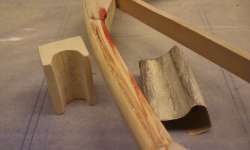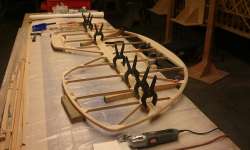By Don | August 28, 2013
 I was sanding the edges of the horizontal stabilizer when I noticed red – hmmm – that didn’t look right! Didn’t realize that the edge of my sanding block was chewing into my palm as I aggressively sanded a radius on the leading and trailing edges of the stabilizer.
I was sanding the edges of the horizontal stabilizer when I noticed red – hmmm – that didn’t look right! Didn’t realize that the edge of my sanding block was chewing into my palm as I aggressively sanded a radius on the leading and trailing edges of the stabilizer.
I’d been sanding for maybe a couple of hours and was pleased with how the radius was coming along, until I saw the blood.
How’d the builders in the 1920s and 1930s get their radius curves? Not really sure but today you’d just use a router and it’d be done nicely in a few hours. But for some crazy reason I decided to manually sand the edges, and I found the experience of manual labor (and the smell of sawdust) to be therapeutic and a nice break from my “real” work as a Realtor.
 The sanding is almost done now. I really like how the curves of the radius are turning out. The right side of the picture is the “fixed” part of the stabilizer. The left side (with the indent) is the elevator that goes up and down, which is what controls the up and down (pitch) of the aircraft.
The sanding is almost done now. I really like how the curves of the radius are turning out. The right side of the picture is the “fixed” part of the stabilizer. The left side (with the indent) is the elevator that goes up and down, which is what controls the up and down (pitch) of the aircraft.
When all the sanding is done, I’ll brush everything with sealer.
Filed under article topic:
Tiger Moth
Comments Off on Some blood shed on the Tiger Moth
By Don | August 19, 2013
 Leslie and I had the privilege of hosting 2 visiting Chinese professors to a little bit of Americana Sunday afternoon, and what better way could there be but on a beautiful summer day take in the sights and sounds of an airshow.
Leslie and I had the privilege of hosting 2 visiting Chinese professors to a little bit of Americana Sunday afternoon, and what better way could there be but on a beautiful summer day take in the sights and sounds of an airshow.
With constant flying overhead, we wandered around looking at airplanes and I enjoyed showing them the Tiger Moth project in our EAA hangar. Our chapter recently acquired a new flight simulator for the Young Eagle program and both of them got some flying time in the simulator.
During the show we’d wander past a cargo plane from WW2 named the “China Doll” (a C-46) and I promised we’d go inside the plane before the show ended. However, we were almost ready to leave when I remembered the China Doll.
 We were one of the last to enter the “flying museum” but John (the docent) explained how American volunteers flew this type of aircraft “over the hump” of the Himalayas from India to Burma to China in support of the Chinese against the Japanese invaders during WW2. The “blood chit” was worn on the flight jackets of the pilots in the event their plane went down and was a message to the Chinese people to help the Americans escape. If the Japanese soldiers caught any of the Chinese helping the Americans, the consequences were brutal. About 900 of those aircraft were lost.
We were one of the last to enter the “flying museum” but John (the docent) explained how American volunteers flew this type of aircraft “over the hump” of the Himalayas from India to Burma to China in support of the Chinese against the Japanese invaders during WW2. The “blood chit” was worn on the flight jackets of the pilots in the event their plane went down and was a message to the Chinese people to help the Americans escape. If the Japanese soldiers caught any of the Chinese helping the Americans, the consequences were brutal. About 900 of those aircraft were lost.
I’d heard of the Flying Tigers but it was good to have that memory refreshed and was a new reminder of the ties that still connect the Chinese and Americans.
Filed under article topic:
Random Stuff,
Transitions
Comments Off on China Doll – Sunday at the Camarillo air show
By Don | August 12, 2013
 I’ve noticed that most new listings are “Standard Sale” listings now – not short sales or REO (bank owned) listings . As a matter of fact, seeing a new short sale listing today is sort of “quaint” – reminiscent of the “bad ol’ days” of the previous few years.
I’ve noticed that most new listings are “Standard Sale” listings now – not short sales or REO (bank owned) listings . As a matter of fact, seeing a new short sale listing today is sort of “quaint” – reminiscent of the “bad ol’ days” of the previous few years.
So I was curious to compare how many Notice of Trustee Sale notices were published for the county in July compared to a year ago – and it’s been cut in half.
July saw 153 recorded notices compared to over 300 last summer, but down substantially from over 500 in January, 2012.
Relatively speaking, very few foreclosures today are actually going to sale. The vast majority get postponed or cancelled as homeowners work things out with their lender.
This net effect has substantially reduced the number of homes for sale, which in turn shows how the supply and demand nature of things work in a free market. But in the long term, it’s not a bad thing. As price points have climbed, many underwater homeowners have now found they have equity again and can plan accordingly. We’re also seeing the move-up market starting up again.
Hopefully, the painful challenges we’ve gone through over the past 5 years or so are now in the rear view mirror.
Comments Off on Foreclosures substantially down – and price points reflect that…
 I was sanding the edges of the horizontal stabilizer when I noticed red – hmmm – that didn’t look right! Didn’t realize that the edge of my sanding block was chewing into my palm as I aggressively sanded a radius on the leading and trailing edges of the stabilizer.
I was sanding the edges of the horizontal stabilizer when I noticed red – hmmm – that didn’t look right! Didn’t realize that the edge of my sanding block was chewing into my palm as I aggressively sanded a radius on the leading and trailing edges of the stabilizer. The sanding is almost done now. I really like how the curves of the radius are turning out. The right side of the picture is the “fixed” part of the stabilizer. The left side (with the indent) is the elevator that goes up and down, which is what controls the up and down (pitch) of the aircraft.
The sanding is almost done now. I really like how the curves of the radius are turning out. The right side of the picture is the “fixed” part of the stabilizer. The left side (with the indent) is the elevator that goes up and down, which is what controls the up and down (pitch) of the aircraft.
 We were one of the last to enter the “flying museum” but John (the docent) explained how American volunteers flew this type of aircraft “over the hump” of the Himalayas from India to Burma to China in support of the Chinese against the Japanese invaders during WW2. The “blood chit” was worn on the flight jackets of the pilots in the event their plane went down and was a message to the Chinese people to help the Americans escape. If the Japanese soldiers caught any of the Chinese helping the Americans, the consequences were brutal. About 900 of those aircraft were lost.
We were one of the last to enter the “flying museum” but John (the docent) explained how American volunteers flew this type of aircraft “over the hump” of the Himalayas from India to Burma to China in support of the Chinese against the Japanese invaders during WW2. The “blood chit” was worn on the flight jackets of the pilots in the event their plane went down and was a message to the Chinese people to help the Americans escape. If the Japanese soldiers caught any of the Chinese helping the Americans, the consequences were brutal. About 900 of those aircraft were lost. I’ve noticed that most new listings are “Standard Sale” listings now – not short sales or REO (bank owned) listings . As a matter of fact, seeing a new short sale listing today is sort of “quaint” – reminiscent of the “bad ol’ days” of the previous few years.
I’ve noticed that most new listings are “Standard Sale” listings now – not short sales or REO (bank owned) listings . As a matter of fact, seeing a new short sale listing today is sort of “quaint” – reminiscent of the “bad ol’ days” of the previous few years.